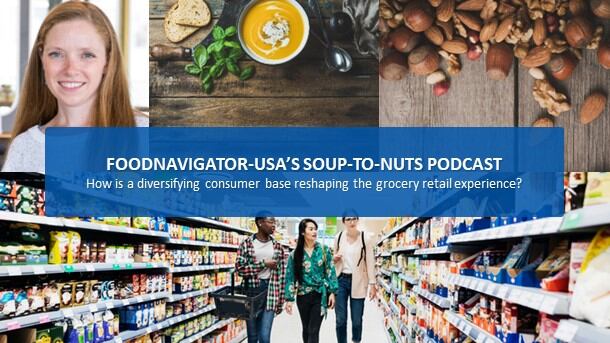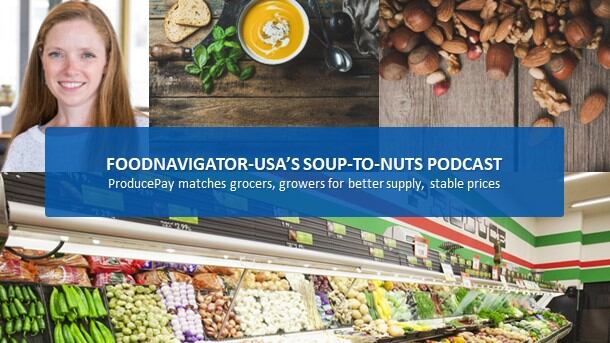For years, grocers have catered to a consumer base they perceived as largely homogenous and with limited options for how to access or buy food – allowing them to operate on razor-thin margins by offer a broad but standard selection of products, mostly produced by trusted brands.
But according to recently released research by Deloitte, growth via this model is increasingly hard to come by as consumer preferences become more specific and differentiated to reflect their racial, ethnic, economic and social diversity and proliferating paths to purchase via ecommerce, personal shoppers and rapid delivery services offer greater selection and shopping opportunities.
In this episode of FoodNavigator-USA’s Soup-To-Nuts podcast, Adam Almond, a principal in the US retail and consumer products industry at Deloitte Consulting shares how these shifts alongside short-term challenges like inflation, labor and supply-chain instability are reshaping the grocery industry and how retailers and manufacturers are responding.
[Editor’s Note: Never miss an episode of FoodNavigator-USA’s Soup-To-Nuts podcast – subscribe today.]
Six ‘forces of change’ are reshaping grocery
Drawing on interviews conducted this summer with 100 senior executives from US based grocery retailers with more than 10,000 employees and insights from earlier research conducted by Deloitte on the future of the consumer industry, Almond shares how the grocery retail landscape is evolving and six “forces of change” which Deloitte found are driving that change.
The first “force of change” behind this evolution that Deloitte identifies is the changing consumer, which Almond says is pushing retailers and manufacturers to move from a “mass to micro” mentality and offer increasingly personalized solutions.
Indeed, Deloitte’s survey found 87% of grocery retailer executives said the marketing of groceries will become hyper-personalized, which Almond notes will require a new toolset to execute successfully. For example, he said, retailers and manufacturers will need to craft marketing based on consumers’ location, trips, meal plans and how they prioritize quality, value, choice and convenience.
The second “force of change” influencing the industry are changing societal and cultural expectations, goals and milestones that are changing both how people shop and the retail workforce.
The rapid evolution and adoption of technology across every aspect of business is the third “force of change” that Deloitte identified and one that Almond says is again impacting not just retailers’ relationships with shoppers but also employees.
Shoppers shifting channels to find value and convenience as they become strapped for time and money in the current economy has been grabbing headlines in recent months. But Almond says Deloitte’s research found radical industry upheaval goes deeper and may not be as transitory as some players once thought. Rather, he says, blurring industry lines are requiring grocery retailers to rethink their role in adjacent spaces and potential partnerships.
One way this is playing out in grocery is retailers are expanding their private label offerings, which is forcing CPG brand manufacturers to rethink their path to the consumer and as such embrace more direct-to-consumer offerings.
The fifth “force of change” revealed by Deloitte’s research is extreme climate shifts, such as this past July, which was the hottest month the world has seen in recorded history, and rising sea levels and temperatures that threaten where crops can grow.
The last “force of change” that Deloitte is tracking is shifting economics, policy and power that are disrupting international food supply chains.
As forces combine their power compounds
According to Deloitte’s research, each of these factors is a force in its own right, but when combined they amount to something more – changing how stakeholders across the industry must think about markets, models and mechanics.
“One of the things that we found helpful with this research is an organizing principle around markets, models and mechanics that really helps us connect the themes and play out some of the implications and choices for the grocery retailers,” said Almond.
He explained, “For markets, specifically, one of the themes that that really jumped out that we touched on around personalization is, is really about macro to micro. So with a more diverse and differentiated consumer base, and the technology, innovation, to enable it, we see … the ability to really have a new macro to micro strategy being something possible that hasn't necessarily previously existed at scale.”
Almond adds that for retailers to make the most of these shifts in markets and models, they will need to consider the resources needed and available, including labor, to execute against the mechanics.
“Grocers will have to make tradeoffs on how they execute and prioritize investments in order to be able to operationalize many of these emerging technologies and … new ways to create value. And so you know, executing on a master micro strategy or driving automation throughout the supply chain … all of those things require a lot of data. And it also largely requires a different skill set from the workforce,” Almond said.
He added: “We also know that the the overall, you know, associate experience is very much a focus area for many retail executives with 84% of executives saying that that store associated experience, needs to be on par with their investments and how they think about the the customer experience as well.”
For Almond, one of the most exciting takeaways from the report is that even though responding to these changing competitive pressures can feel overwhelming, these shifts are also opening new addressable markets for players across the grocery industry. He also encourages those who are looking to make the most of these changes to check out the full report on Deloitte’s website.




